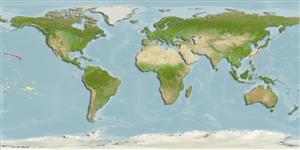Environment: milieu / climate zone / depth range / distribution range
Ecology
Marine; reef-associated; depth range 0 - 250 m (Ref. 58302). Tropical
Eastern Central Pacific: Johnston Island (Ref. 11013) and Hawaii.
Size / Weight / Age
Maturity: Lm ? range ? - ? cm
Max length : 13.0 cm SL male/unsexed; (Ref. 4858)
Dorsal spines (total): 13 - 14; Dorsal soft rays (total): 20 - 23; Anal spines: 2 - 3; Anal soft rays: 17 - 20. Body is generally yellow or white with vertical rows of spots on the sides. A broad black bar runs vertically through eye from edge of sub opercle, and a black spot is on the caudal peduncle.
Inhabit shallow reef flats (Ref. 205). Benthopelagic (Ref. 58302). Form schools at midwater to feed on plankton and benthic invertebrates. Also on shallow seamounts. Oviparous. Form pairs during breeding (Ref. 205).
Life cycle and mating behavior
Maturity | Reproduction | Spawning | Eggs | Fecundity | Larvae
Distinct pairing (Ref. 205).
Jordan, D.S. and B.W. Evermann, 1973. The shore fishes of Hawaii. Charles E. Tuttle Company, Rutland, Vermont. 392 p. (Ref. 2826)
IUCN Red List Status (Ref. 130435: Version 2024-2)
Threat to humans
Harmless
Human uses
Fisheries: commercial; aquarium: commercial
Tools
Special reports
Download XML
Internet sources
Estimates based on models
Preferred temperature (Ref.
123201): 15.3 - 21.7, mean 19.2 °C (based on 10 cells).
Phylogenetic diversity index (Ref.
82804): PD
50 = 0.5000 [Uniqueness, from 0.5 = low to 2.0 = high].
Bayesian length-weight: a=0.02818 (0.01526 - 0.05207), b=3.04 (2.88 - 3.20), in cm total length, based on LWR estimates for this species & Genus-body shape (Ref.
93245).
Trophic level (Ref.
69278): 3.0 ±0.0 se; based on diet studies.
Generation time: 1.0 ( na - na) years. Estimated as median ln(3)/K based on 1
growth studies.
Resilience (Ref.
120179): High, minimum population doubling time less than 15 months (K=1.13).
Fishing Vulnerability (Ref.
59153): Low vulnerability (12 of 100).
Nutrients (Ref.
124155): Calcium = 109 [55, 175] mg/100g; Iron = 1 [1, 2] mg/100g; Protein = 18.2 [16.9, 19.4] %; Omega3 = 0.142 [0.078, 0.256] g/100g; Selenium = 46.8 [22.3, 97.5] μg/100g; VitaminA = 77.5 [19.8, 283.8] μg/100g; Zinc = 1.45 [0.95, 2.11] mg/100g (wet weight);
